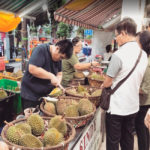In Southeast Asia, you don’t have to look for durian. The strong smell of this boulder-like fruit will find you. Many travelers lose their appetite when the fiercely ripe smell of durian burns their nostrils. But sampling the iconic “king of fruits” is a rite of passage, allowing you to tap into the intriguing aspects of Asian food cultures. After all, it’s not just the nutritional qualities of the durian that make them so valuable. The significance of the fruit is also reflected in the idiom: in Indonesia, unexpected accidents are compared to a ripe durian falling off a tree. Choosing and eating durian is part science, part art form, and surprisingly sociable. Here’s everything you need to know about this most infamous of Asian delicacies.
Get to Know Durian
The distinctive smell of durian is mirrored by its equally strange appearance. Durians are prickly green cannonballs; their prongs, Durians in Bahasa Malaysia and Bahasa Indonesia give the fruit its name. The largest ones weigh up to 3 kilograms, as heavy as a bowling ball. And to many, a bowling ball sounds much lighter than this polarizing fruit, often described with the euphemism “it’s an acquired taste.”
Durian, A Favorite Fruit
The prickly greenish rind covers the seeds, wrapped in the sticky yellow pulp. This edible pulp ranges from creamy and creamy to amber and stringy. For fans, the durian tastes warm, nutty, with a throaty smell reminiscent of cheese or onion. For durian lovers, it’s a different story: the onion flavor is striking, the fruity overripe ripeness obscured by a pong of raw foulness – subtle notes that can be seen on a wine menu. So, in Singapore, you can find special stalls with durian and taste this exquisite fruit.

- Automotive
- Beauty & Spas
- Home Services
- IT Services & Computer Repair
- Pets
- Professional Services
- Accountants
- Advertising
- Air Conditioning
- Banks & Credit Unions
- Carpet Cleaning
- Coaching
- Consulting and Advisory
- Creative Industry
- Education
- Employment Agencies
- Floral Services
- Funeral Services
- Interior Furnishing
- Legal Services
- Medical Centers
- Metal Fabrication
- Mobile Phone Services
- Music Industry
- Office Cleaning
- Online Media
- Online Shopping
- Other Services
- Party & Event Planning
- Payroll Services
- Private Investigation
- Real Estate
- Retailing/Distribution
- Tailoring
- Translation Services
- Wedding Planning
- Restaurants
Registration №: 202016312D
Company Name: GIPNETIX PTE. LTD.
Company Type: Exempt Private Company Limited by Shares
Company Address: 195 PEARL'S HILL TERRACE Singapore 168976
Phone: +6531594178

